|
by Daniel Hudon
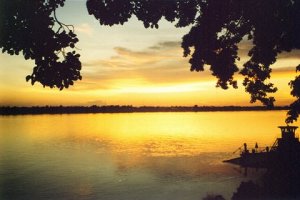
Mekong Sunset
1. Tha Kaek
I can't get enough of the Mekong. It lies alongside my travels in this country like a quiet and dependable companion who continues to remind me of the slow pace of life here. Despite all the miles covered, during three weeks in Laos, I have only missed two Mekong sunsets. They are like a secret attraction that even the guidebooks don't know about. Now the sun has almost disappeared into the temple of clouds and the goddess begins combing her luminous hair before bed. After arriving in town I came upon another foreigner, Linda, from Holland, who worked here on a fisheries project. Not many foreigners stop in Tha Kaek and she was surprised to see me. We shared a beer and compared our reasons for being here. She told me she was worried that once the project ended and the money dried up, the work and training would be lost. It was clear she hadn’t talked to another foreigner in awhile and my questioning seemed to bring out all her complaints: ninety people in the fisheries office did the work of thirty, and fifty to sixty people in the forestry office did nothing because Laos was busy selling their forest to the Thais who have already cut down all theirs. Then there were the high profile UN Development Projects like building roads and bridges while three hundred students in the school shared one textbook — in Russian. She smiled brightly, as if hoping it wasn't really that bad. Across the river, over Thailand, the clouds are swelling into pink and purple. A short French man, sitting at the next table at the restaurant, joins me on the wall and we try to decide when will be the best time to take a photo. We talk about our travel experiences in Laos. He and his two teenaged kids are enjoying it a great deal, but his wife, who was born here then left at the age of ten when both her parents were killed, is having a difficult time dealing with her childhood memories. From the guidebooks, I'm aware that Laos is the most bombed country on Earth as the Americans dropped untold tons of ordnance on it in an effort to disrupt the Ho Chi Minh Trail and wipe out the Lao communists during the Vietnam War. As the clouds glimmer between purple and amber, he takes his photo and goes back to rejoin his family. This morning, a burly German and I grabbed the last two seats on a bus out of Vientiane and soon, as we picked up more passengers, it was packed to overflowing. When I told him where I was from, he said to me, in strongly accented English, "It is my dream to ride across Canada on a motorbike. Since I was a teenager, it has been my dream." As I looked out on the rice fields, Canada suddenly seemed to me like a distant, mythical land of wide open spaces and uncrowded buses. The road was well-paved for most of the way, but in the stretches of dirt road, we banged through a series of potholes that launched everyone off their seats. I remembered stories from other travellers who told about the worst roads they've ever been on and the fact that they were all located in Laos. After the big bumps, the German laughed his burly laugh. Despite my foul mood during much of the eight-hour trip, the sunset is worth it. The sky is aflame. Leave it out of the guidebooks, I think, let this be the traveller's own discovery. Down the horizon, lightning splays over the thunderheads. After an hour-long display of colour, now only a ribbon of purple lingers on the horizon. I cross the street to pick up my belongings and pay for my meal at the restaurant. The French man is still there with his family and I make a point of greeting his wife as warmly as I can. She seems weary while her kids are boisterous and chatty; they ask me lots of questions. My French seems to be getting worse instead of better, but I answer them as best I can and wish them well on their vacation. On the way back to my guesthouse, I look for any sign of colour on the horizon — it is completely dark. 2. Pakse
There's a saying that while the Thai plant the rice and the Vietnamese sell it, the Lao listen to it grow. It seems to hold grains of truth. I team up with a pair of Scots, John and Laura, and we make arrangements to rent a car to see some nearby sites. For some reason, we can't drive it ourselves and must rent the driver as well. In the morning, a car pulls up to the hotel, but the driver sits there without giving any indication that he wants to go somewhere or that he's ours for the day. Twice we ask if he's from the company, but he doesn't say anything. We should have rented an interpreter as well. After forty-five minutes he drives away. We trek over to the company learn that, indeed, he was our driver and the price has now changed. Reasoning with the lackadaisical salesman is useless. "Talk to my manager," he says, knowing full well that the manager speaks no English and we speak no Lao. We try two other companies, but bargaining is an exercise in frustration. All the companies have the same (government-approved) price sheet for the various destinations, and after we push the price down it mysteriously goes back up. Though there are no other customers, no one seems to care if we rent from them or not. "It's our last day in Laos," John says to Laura. His expression clearly adding and we have yet to see a single point of interest.
"Maybe there's a taxi," Laura grins, trying to be upbeat. "Do you suppose we can take a taxi out of Pakse?" Later, I find out there's another Lao saying, "Maybe tomorrow, or someday." If only we'd known it sooner. Finally, we finally settle on a car and driver and hit the road. * * *
It doesn't feel right. We're visiting a Katu village on the Bolaven Plateau while our driver waits for us in the car. A pair of young men watch us wander around the thatched bamboo huts, uncertain of what to make of us. It’s not that I feel unwelcome. Rather, I wonder why we’re intruding. We've brought nothing to trade or share. Nor did we hire an interpreter, so we have no way of communicating with the villagers. Taking photos feels funny, like we’re poaching. One of the village customs is to make wooden caskets for family members long before their expected death. Beneath one of the huts, several are stacked up. Some are much smaller than the others — children's coffins. At a nearby home, John inspects a cylindrical plant pot and finds it’s an American bombshell. The date and serial number are barely visible: 1967. Part of the "secret" war. I think of the Lao-French woman I met in Tha Kaek, orphaned at the age of ten and Amy, an American I met at the border. She was bubbling over from her visit with tales of friendliness. Then she sighed, "How could we do that to such a gentle people?" As we leave the village, we notice a woman weaving next to her home. Finally, we look like we have a reason for being here — to buy textiles. She takes a break and unrolls for us a finished fabric with an intricate design. We make suitable exclamations of admiration. Then we smile and say, "No thanks, we’re just looking," and try to make a graceful exit. 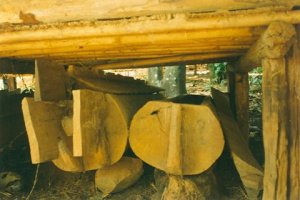 Children's coffins at Katu village Children's coffins at Katu village
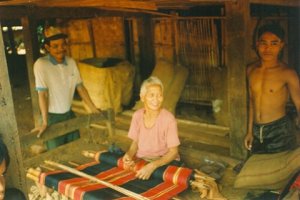
Weaving woman and friends in Katu village* * * At last, another waterfall. Here we know exactly what to do. An avalanche of water at least three temples wide spills over a ledge of the Plateau. John and I creep around to the boulders beneath one of the twelve spouts and get pummelled by the falling water before diving in. (Laura forgot her bathing suit and despite our cajoling, refuses to come in.) Though I’ve been washing daily, a shower usually consists of a few buckets of cold water over the head. This is a bona fide Jacuzzi bath. The water is cold and the current strong. It rolls over me like a liquid massage. I can feel the layers of bus-dust being rubbed off my body and my bones are clicking back into their places. My body is slowly being redeemed from so many long, hard bus and boat rides. Later, Roberto, who I’ve been bumping into all over Laos, shows up like a genie and immediately starts pouring shots of lào láo. We sit for a while in the mists, warmed by the sun. 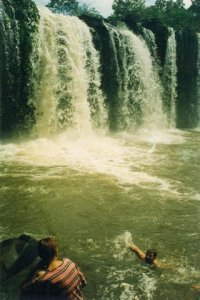 Waterfall on Bolaven plateau Waterfall on Bolaven plateau
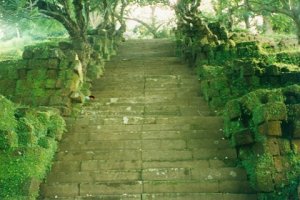 Stairway at Wat Phu Stairway at Wat Phu
3. Wat Phu, Champasak
The Mountain Temple. Or what’s left of it. The ruins are about 1400 years old and pre-date those over the border at the great temple-city Angkor Wat in Cambodia. I phoned my parents a couple of days ago and was disappointed to hear that King Sihanouk of Cambodia had appeared on television, warning foreigners not to visit due to recent Khmer Rouge activity, so I’ve made a special effort to come here. This is a small consolation since Angkor Wat is one of the places I most wanted to go. But, as soon as I get a glimpse of the weathered stone buildings lurking in the hillside forest, I’m excited. I walk down the processional causeway, flanked by rectangular reservoirs, imagining I’ve been summoned by the god-king. On either side, villagers fish in the water. The steep, ancient stairway is shrouded in a canopy of plumeria, the Lao national tree, and diligent roots split the stone. Moss grows everywhere. It’s late in the afternoon, few other tourists are about and I ascend in silence. On the middle level stand the remains of two sandstone pavilions with caved-in roofs. Long buildings with bold facades, they look like locomotives set to steam off the mountain over the plains. Pillars lean this way and that. I climb through the doorways and leap from one fallen stone block to another, careful not to touch the tall grass as if it were sacred, like Whitman's "beautiful uncut hair of graves." Another steep stairway leads to the main sanctuary at the top. Carvings around the doorways depict Hindu deities from the temple's earliest days: Indra riding a three-headed elephant, Siva tearing a woman in two, Parvati looking voluptuous and beautiful. An apsara dances in stone for me today just as she did for the god-king centuries ago, her nipples still erect. I weave through the various doorways, trying to absorb more of the detail, wondering where the gods went once the temple fell to ruin. The walls open to the sky. A few Buddhist statues, more recent occupants, sit calmly in the centre, meditating. The temple is backed by a sharp cliff and vines hang down from the trees above — the conquering jungle. I take in the view: the lower levels and the long promenade leading right up to me, the fishermen standing small by the ponds and, as far as I can see, the wide plains dotted with trees. Mammoth white clouds gather on the horizon and suddenly I feel large and powerful, part of the rise and fall of kingdoms in the long thread of time. 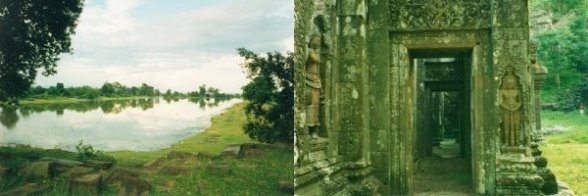 Left: Wat Phu reservoir Left: Wat Phu reservoir
Right: Wat Phu doorway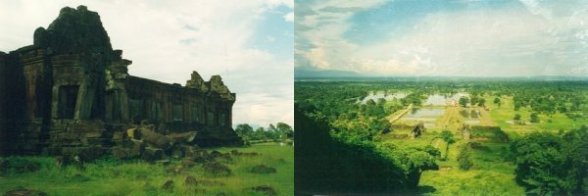
Left: Ruined pavilion at Wat Phu
Right: View from above Wat Phu
4. Don Khong Island
Two candles burn — a small altar of night. A fly has spiralled into one of them and sacrificed himself in the hot wax. Goodbye fly. Two candles and a million stars, all flickering. And bugs. A thousand aphids flying up my nose, moths circling my head, mosquitoes zooming around looking for my flesh, gnats hopping on my legs, my neck, my glasses. The generator has gone out and all the other travellers have gone to bed. I just want to be alone with my two candles and million stars but all the bugs on the island want to join me. I am grouped out, bargained out and moneyed out. We didn't even try for a better price for the waterfall tour tomorrow from our madame. Our madame of the prix-fixe meals and the fixed accommodation price. Non monsieur, j’ai dit ... Our patronizing, money-making madame. I watch a moth fly into one of the candles and get hot wax on one of his wings. He is stuck there a moment, dazed I suppose, then slips down to the base. The wax quickly hardens and he wriggles his body and flaps his other wing to free himself. I push him off with my pen but I'm not sure I've helped him much — he has too much wax on his wing to fly. I should put him out of his misery. A hot stab through his heart. A little sting of wax. A dagger of starlight. The madame's dog is asleep under my chair, all the rooms are quiet. Gnats continue jumping onto my paper, my legs, flying up my nose. A mosquito squeals in towards my ear. I should have repellent on but I hate the stuff. Wax drips off the candle. If it splashes — or the moth keeps wriggling — he will find himself in a very hot spot. Above, the stars wait. In the distance, the wide, brown Mekong River slides noiselessly by. Somewhere downstream, close to the border of Cambodia, two hours away by boat and jeep, it crashes into a ragged cascade waterfall. Somewhere out there, too, crickets count off the night. It's time to blow out the altar and find my solitude in sleep. The moth has stopped moving. Has he gotten the fatal splash? No, a poke draws a flutter. What do you want, Moth?5. Khone Falls
Here is the Mekong frothing at the mouth. Ten thousand tongues of water licking the stones, salivating down craggy chutes, gurgling and foaming. One of the falls is called Khone Yai — the Voice of the Mekong. This is the viscous breath of the Mekong, rolling down from the Tibetan Plateau, whispering the whims of the spirits, passing on secrets collected along the way, the Buddha’s precepts and washer-women's gossip, the fishermen's stories, old people's laughter, dreams of travellers embarking on new adventures and children's shouts at play.
Last night I saw a floating offering: a candle burning in some folded leaves and flickering down the river. A prayer told to the river. Where is it now? Burnt — free to become air, wind and sky? Or is it trailing along, a story told to the river and spilled all over the world? Or, is it too thrashed upon the rocks, leaving a debris of letters and sounds?
Downstream, the Mekong is calm again and we can swim to Cambodia.
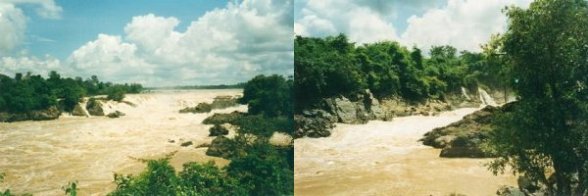
Khone Yai waterfall (Parts of "Travel to the Bottom of Laos" were first published in The Antigonish Review. The pictures that accompany the piece are first published in Issue #5 of Cha.) |